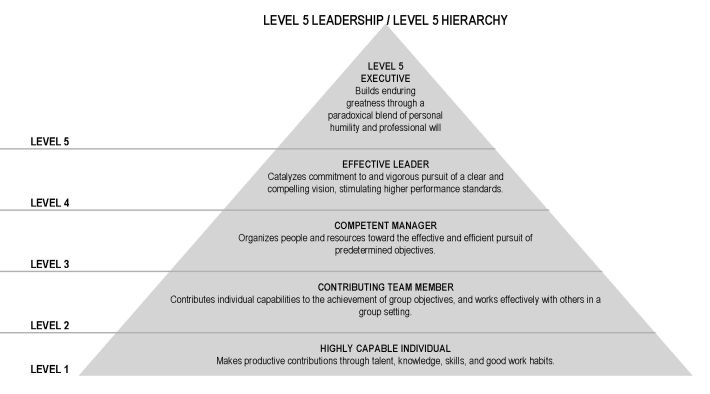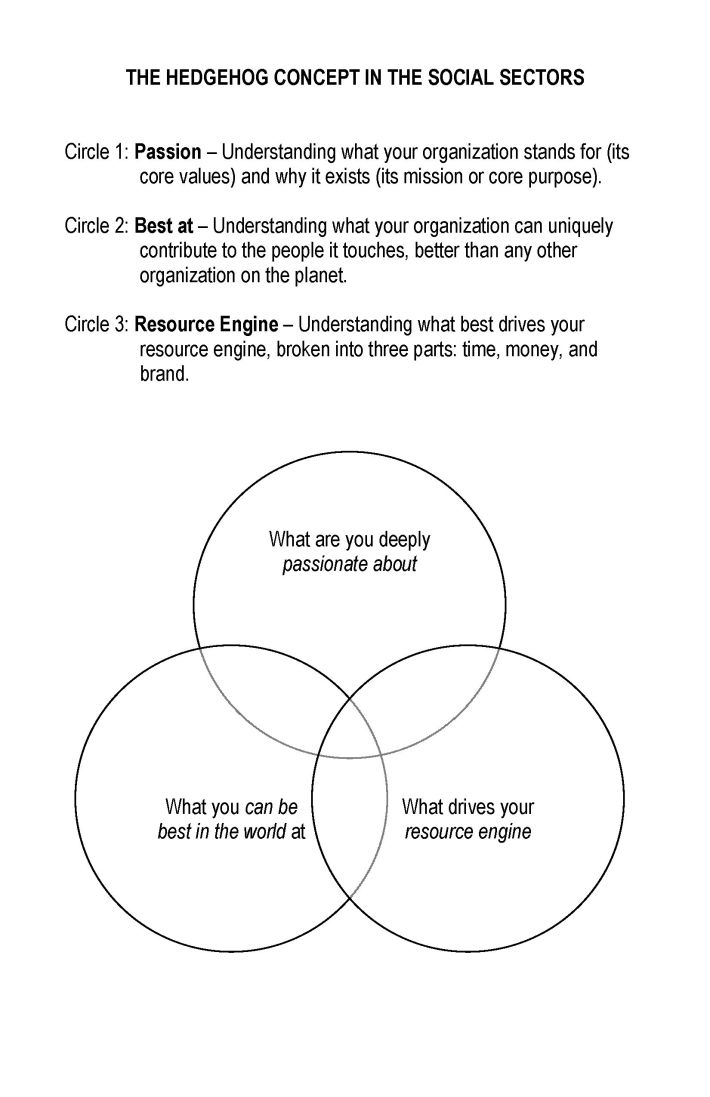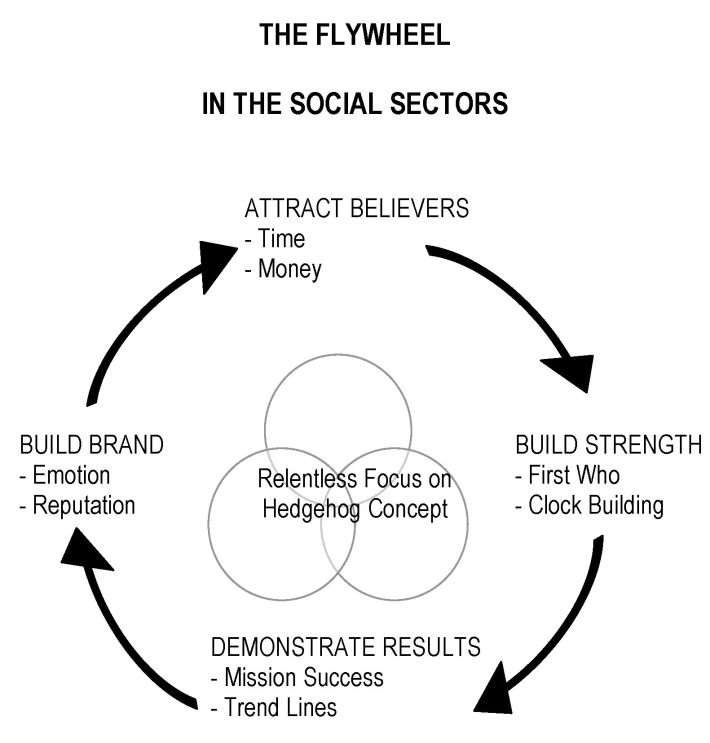Jim Collins. Good To Great and the Social Sectors: A Monograph to Accompany Good to Great (Why Business Thinking is not the Answer). Harper-Collins, 2005. (35 pages)
How do social sector organizations ‘calibrate success without business metrics,’ ‘get things done within a diffuse power structure,’ ‘get the right people on the bus within social sector constraints,’ rethink the economic engine without a profit motive,’ and ‘build momentum by building the brand?’ (3)
If we only have great companies, we will merely have a prosperous society, not a great one. Economic growth and power are the means, not the definition, of a great nation. – Author’s Note
“We must reject the idea–well-intentioned, but dead wrong–that the primary path to greatness in the social sectors is to become ‘more like a business.’ Most businesses–like most of anything else in life–fall somewhere between mediocre and good. Few are great. … So, then, why would we want to import the practices of mediocrity into the social sectors?” (1)
A culture of discipline is not a principle of business; it is a principle of greatness. (1)
ISSUE ONE: DEFINING “GREAT”–CALIBRATING SUCCESS WITHOUT BUSINESS METRICS
The confusion between inputs and outputs stems from one of the primary differences between business and the social sectors. In business, money is both an input (a resource for achieving greatness) and an output (a measure of greatness). In the social sectors, money is only an input, and not a measure of greatness.
“For a social sector organization, performance must be assessed relative to mission, not financial returns. The critical question is ‘How effectively do we deliver on our mission and make a distinctive impact, relative to our resources?’ ” (5)
It doesn’t really matter whether you can quantify your results. What matters is that you rigorously assemble evidence–quantitative or qualitative–to track your progress. If the evidence is primarily qualitative, think like a trial lawyer assembling the combined body of evidence. If the evidence is primarily quantitative, then think of yourself as a laboratory scientist assembling and assessing the data. (7)
“To throw up our hands and say, ‘But we cannot measure performance in the social sectors the way you can in a business’ is simply a lack of discipline.” (7)
“What matters is not finding the perfect indicator, but settling upon a consistent and intelligent method of assessing your output results, and then tracking your trajectory with rigor.” (8)
No matter how much you have achieved, you will always be merely good relative to what you can become. Greatness is an inherently dynamic process, not an end point. The moment you think of yourself as great, your slide toward mediocrity will have already begun. (9)
ISSUE TWO: LEVEL 5 LEADERSHIP–GETTING THINGS DONE WITHIN A DIFFUSE POWER STRUCTURE
“There is power of inclusion, and the power of language, and the power of shared interests, and the power of coalition. Power is all around you to draw upon, but it is rarely raw, rarely visible. (10)
Social sector leaders are not less decisive than business leaders as a general rule; they only appear that way to those who fail to grasp the complex governance and diffuse power structures common to social sectors. (10)
There are two types of leadership skill: executive and legislative. “Legislative leadership relies more upon persuasion, political currency, and shared interests to create the conditions for hte right decisions to happen. And it is precisely this legislative dynamic that makes Level 5 leadership particularly important to the social sectors.” (11)
I’ve learned that Level 5 leadership requires being clever for the greater good. In the end, it is my responsibility to ensure that the right decisions happen…I’m motivated first and always for the greatness of our work, not myself.” (11)
Level 5 leadership is not about being “soft” or “nice” or purely “inclusive” or “consensus-building.” The whole point of Level 5 is to make sure the right decisions happen–no matter how difficult or painful–for the long-term greatness of the institution and the achievement of its mission, independent of consensus or popularity. (11)
“The best leaders of the future–in the social sectors and business–will not be purely executive or legislative; they will have a knack for knowing when to play their executive chips, and when not to. … I suspect we will find more true leadership in the social sectors than the business sector. How can I say that? Because…the practice of leadership is not the same as the exercise of power.” (12)
True leadership only exists if people follow when they have the freedom not to. (13)
 ISSUE THREE: FIRST WHO–GETTING THE RIGHT PEOPLE ON THE BUS, WITHIN SOCIAL SECTOR CONSTRAINTS
ISSUE THREE: FIRST WHO–GETTING THE RIGHT PEOPLE ON THE BUS, WITHIN SOCIAL SECTOR CONSTRAINTS
[Fill your seats] with people compulsively driven to make whatever they touch the best it can be–not because of what they would “get” for it, but because they simply could not stop themselves from the almost neurotic need to improve. (13)
First, and most important, you can build a pocket of greatness without executive power, in the middle of an organization. Second, you start by focusing on the First Who principle–do whatever you can to get the right people on the bus, the wrong people off the bus, and the right people into the right seats. Third, accomplish all this with the use of early-assessment mechanisms, rigorously employed. (14)
In the social sectors, where getting the wrong people off the bus can be more difficult than in a business, early assessment mechanisms turn out to be more important than hiring mechanisms. There is no perfect interviewing technique, no ideal hiring method; even the best executives make hiring mistakes. You can only know for certain about a person by working with that person. (15)
“The comparison companies in our research–those that failed to become great–placed greater emphasis on using incentives to ‘motivate’ otherwise unmotivated or undisciplined people. The great companies, in contrast, focused on getting and hanging on to the right people in the first place–those who are productively neurotic, those who are self-motivated and self-disciplined, those who wake up every day, compulsively driven to do the best they can because it is simply part of their DNA.” (15)
“Lack of resources is no excuse for lack of rigor–it makes selectivity all the more vital.” (15)
Three fundamental points:
“First, the more selective the process, the more attractive a position becomes–even if volunteer or low pay. Second, the social sectors have one compelling advantage: desperate craving for meaning in our lives. Purity of mission–be it about educating young people, connecting people to God, making our cities safe, touching the soul with great art, feeding the hungry, serving the poor, or protecting our freedom–has the power to ignite passion and commitment. Third, the number-one resource for a great social sector organization is having enough of the right people willing to commit themselves to mission. The right people can often attract money, but money by itself can never attract the right people. Money is a commodity; talent is not.” (17)
ISSUE FOUR: THE HEDGEHOG CONCEPT–RETHINKING THE ECONOMIC ENGINE WITHOUT A PROFIT MOTIVE
The essence of a Hedgehog Concept is to attain piercing clarity about how to produce the best long-term results, and then exercising the relentless discipline to say, “No thank you” to opportunities that fail the hedgehog test.
- What are you deeply passionate about?
- What can you be the best in the world at?
- What drives your economic engine?
The third circle of the Hedgehog Concept shifts from being an economic engine to a resource engine. The critical question is not “How much money do we make?” but “How can we develop a sustainable resource engine to deliver superior performance relative to our mission?” (18)
I submit that the resource engine has three basic components: time (how well you attract people willing to contribute their efforts for free, or at rates below what their talents would yield in business), money (sustained cash flow) and brand (how well your organization can cultivate a deep well of emotional goodwill and mind-share of potential supporters).
 The foundation for doing good is doing well – Peter Drucker
The foundation for doing good is doing well – Peter Drucker
To which I would add that the foundation for doing well lies in a relentless focus on your Hedgehog Concept.
ISSUE FIVE: TURNING THE FLYWHEEL–BUILDING MOMENTUM BY BUILDING THE BRAND
People want to feel the excitement of being involved in something that just flat out works. When they begin to see tangible results–when they can feel the flywheel beginning to build speed–that’s when most people line up to throw their shoulders against the wheel and push. (24)
This is the power of the flywheel. Success breeds support and commitment, which breeds even greater success, which breeds more support and commitment–round and around the flywheel goes. People like to support winners!
Social sector funding often favors “time telling”–focusing on a specific program or restricted gift, often the brainchild of a charismatic visionary leader. But building a great organization requires a shift to “clock building”–shaping a strong, self-sustaining organization that can prosper beyond any single programmatic idea or visionary leader. Restricted giving misses a fundamental point: to make the greatest impact on society requires first and foremost a great organization, not a single great program. (24-5)
…the best thing supporters can do is to give resources that enable the institution’s leaders to do their work the best way they know how. Get out of their way, and let them build a clock!
The key driver in the flywheel: brand reputation–built upon tangible results and emotional share of heart–so that potential supporters believe not only in your mission, but in your capacity to deliver on that mission! (25)
Consistency distinguishes the truly great–consistent intensity of effort, consistency with the Hedgehog Concept, consistency with core values, consistency over time. enduring great institutions practice the principle of Preserve the Core and Stimulate Progress, separating core values and fundamental purpose (which should never change) from mere operating practices, cultural norms and business strategies (which endlessly adapt to a changing world). (26)
Remaining true to your core values and focused on your Hedgehog Concept means, above all, rigorous clarity not just about what to do, but equally, what to not do.
Social sector leaders pride themselves on “doing good” for the world, but to be of maximum service requires a ferocious focus on doing good only if it fits with your Hedgehog Concept. To do the most good requires saying “no” to pressures to stray, and the discipline to stop doing what does not fit. (27)
“There is absolutely nothing we could have done to be of better service at that moment than to stick with what we do best, standing firm behind our core values of great music delivered with uncompromising artistic excellence” – Tom Morris
In the social sectors, I’ve encountered an interesting dynamic: people often obsess on systemic constraints. (29)
However, in the meantime, what are you going to do now? This is where the Stockdale Paradox comes into play: You must retain faith that you can prevail to greatness in the end, while retaining the discipline to confront the brutal facts about your current reality. What can you do today to create a pocket of greatness, despite the brutal facts of your environment? (30)
Greatness is not a function of circumstance. Greatness, it turns out, is largely a matter of conscious choice, and discipline.
SUMMARY DIFFERENCES BETWEEN BUSINESS AND SOCIAL SECTORS THROUGH THE GOOD
— via —
Love it.




Pingback: How to choose your career? – My Zen Path
Pingback: A Origem do Famoso Gráfico de Venn do Ikigai | Pensamentos Inquietantes Ou Com Vida Própria
Pingback: DEFINING EFFECTIVENESS IN THE SOCIAL SECTOR
Pingback: HOW TO ATTRACT THE RIGHT VOLUNTEERS
Pingback: EVALUATING NONPROFIT MISSION MOTIVATION
Pingback: DONATION AND REVENUE STREAMS: WHAT DRIVES YOUR RESOURCE ENGINE
Pingback: BUILDING IMPACT AND SUSTAINING MOMENTUM IN THE COMMUNITY